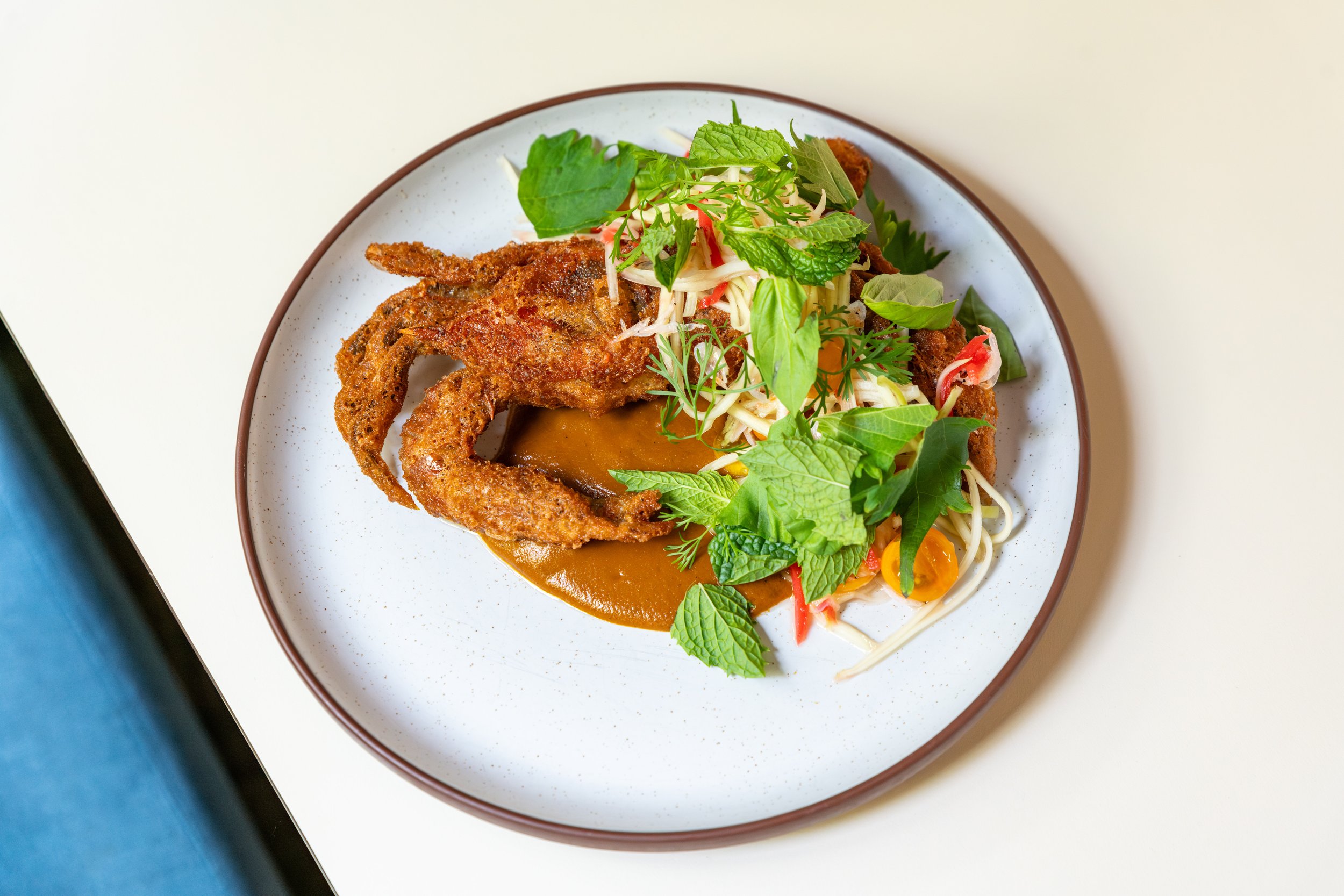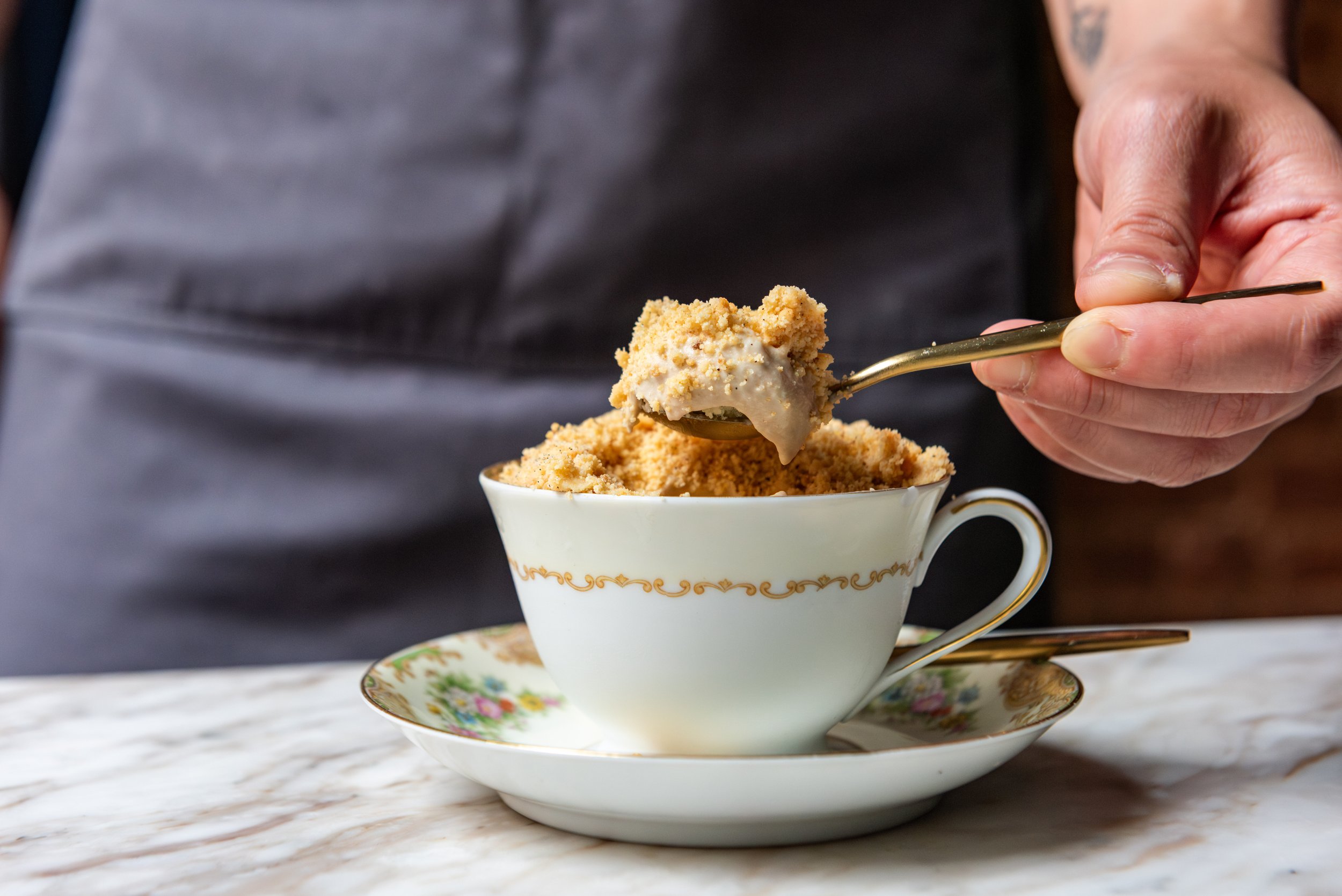D.C.-Chesapeake Kitchen Notebook
An in-depth look at some of our favorite dishes and cocktails from our time on the ground in Virginia, Maryland, and Washington D.C.
Photo: will blunt
SCHNITZEL SOUR
At Trummer’s Restaurant in Clifton, Virginia, Austria-born Restaurateur and Rising Stars alum Stefan Trummer builds a menu of familiar dishes like Schnitzel served with lingonberry jam. “Schnitzel and lingonberry is something I’m always eating,” says Bar Manager Mike Marino. “I love the bitterness and sweetness together.” To transform the familiar flavors into a sophisticated sip, Marino leaned on an old favorite. “Singani is super floral, it’s been one of my favorite spirits for a really long time,” he says. The brandy, distilled in Bolivia from muscat grapes, has a profile that resembles Pisco, so it made sense to shake that Singani into a sour variation with lingonberry and rosemary simple syrup. “The herbaceous rosemary complements the lingonberry and floral notes of the Singani,” says Marino. Refreshing and smooth, lightly floral, with bright fruit and the lush body of an egg white, the Shaker on Mute is a Bolivian-Austrian-inspired sour that’s right at home in Virginia.
PAKSIW NA ISD
When modernizing recipes from her childhood, Chef de Cuisine Julie Cortes wants to make her grandmother proud. This is especially true for her grandmother’s favorite dish, paksiw na isda, where, traditionally, fish is gently simmered in vinegar. “It’s my grandmother’s recipe but I’m going to make my own twist,” says Cortes. So rather than simmering her fresh Chesapeake Bay rockfish, Cortes seasons the fish with ginger, garlic, and salt, wraps it in banana leaves, and grills it on Kaliwa’s open hearth grill—subtle twists meant to prevent mushiness and oversaturation. To honor the vinegar element of the dish, Cortes simmers a punchy sauce of fish stock, fish sauce, vinegar, coconut milk, and lots of aromatics. The rockfish, served inside the scorched banana leaf, is smothered with the creamy paksiw sauce and finished with a sprinkle of coconut flakes. Streamlined for busy dinner service, Cortes’s dish has all of the acidity, unctuousness, and familiarity of her grandmother’s paksiw na isda.
Full Recipe: Rockfish Paksiw: Banana Leaf-Wrapped Rockfish, Paksiw Sauce, and Coconut Flakes
photo: will blunt
photo: Ania Cywińska
XO RAGÙ
Tonari, Rising Stars alum Katsuya Fukushima’s Wafu Italian restaurant, is hardly “fusion.” “You can always fuse cuisine together,” says Chef de Cuisine Nico Cezar. “But Wafu is ubiquitously Japanese.” Wafu Italian was born post-World War II, when Japanese chefs hoped to replicate Italian cooking. But unable to source Italian ingredients, they used what they had on hand, like swapping ramen noodles for spaghetti or ketchup for marinara sauce. Cezar’s “Ex-Ohh” sauce, for example, starts with finely chopped Chinese sausage, pepperoni, Spam, and bonito flakes to mirror the smokiness of bacon. The preserved meats are rendered in oil, then set aside for aromatics and an earthy Okinawan sugar to cook in the fat, before the meats are thrown back into the pan to simmer with dried scallops and shrimp for an added layer of umami and briney salt. Pillowy Hokkaido flour gnocchi are added to the assertively funky XO and the pasta water blends with the meaty oils to create a glossy, ragù-like sauce. Finished with a generous sprinkle of breadcrumbs, orange zest, and parsley, the gnocchi nails the Wafu Italian flavor profile. “All the umami. All the natural salt,” says Cezar. “It’s a very forward-tasting dish.”
CRAB POT PIE
When Chef Armani Johnson designed his first menu for the now-shuttered ABC Pony, he looked to his team for inspiration. As they shot ideas back and forth, a line cook suggested a crab pot, which got Johnson’s wheels turning. He liked the sound of crab, and that reminded him of a crab dip his mother would make for football Sundays. The restaurant had also been churning out Johnson’s cheesy biscuits for weeks and he figured, why not combine the two? “I thought we could do crab dip with cheddar biscuits baked on top. More like a casserole.” The dish starts with the lump crab dip—indulgent and warm with cream cheese, caramelized onions and leeks, lots of hot sauce, mustard, and Old Bay. For the biscuits, Johnson folds melted butter into an as-cold-as-possible dry mix. The dough is piped over the crab mixture and as it bakes, the shards of butter steam out to create flakey, lamination-like layers. A big scoop of the makeshift pot pie allows that soft, cheddar biscuit to soak up all the sweet and salty juices of Armani’s crab dip.
Photo: will blunt
photo: will blunt
CHILCANO CHAR SIU
At the José Andrés restaurant, China Chilcano, Chef Will Fung’s menu walks guests through the history of Peruvian cuisine and its Chinese and Japanese influences. “The cuisine style leads to a lot of exploration,” says Fung. “It was shaped through immigration over the centuries.” Born and raised in Hong Kong, Fung blends in his own story with a Cantonese-style barbecued char siu pork. While American barbecue cooks meat via dry smoke, Fung says that Cantonese barbecue relies on steam to cook smaller portions of meat which shortens the cook time. For the char siu, slabs of pork shoulder marinate overnight in a sauce of maltose, honey, hoisin, molasses, fermented bean curd, and annatto then cooked in a combi oven with 40 percent humidity. Sliced to order, the pork is served with bao, Japanese-style pickled daikon and an array of sauces: Peruvian salsa criolla and rocoto sauce and Cantonese-inspired ginger scallion oil and tamarind hoisin. “A lot of Peruvian cuisine is about finding things that taste like home while utilizing things that are new to you,” says Fung. “It’s a little slice of home in a new surrounding.”
BEEF & BROCCOLI
Chef Yuan Tang’s new American restaurant, Rooster & Owl, is located less than 25 miles from his parents' former Chinese takeout spot in Woodbridge, Virginia. When broccoli came in season, Tang found inspiration from a dish that he saw his father make thousands of times: beef and broccoli. For the beef, he braises short ribs in red wine and chicken stock with bold aromatics like star anise and fennel seeds. A sweet and funky fish sauce gastrique blankets the tender meat and creates a sticky surface for Thai chile fried peanuts. The broccoli florets are roasted; some are saved to be served alongside the beef, while the rest are blended with cilantro and scallion into a smooth purée. The short rib is placed atop the bright green purée and topped with crispy sweet potato straws for crunch. The dish provides a full circle moment for Tang, who is a third generation restaurateur.
photo: will blunt
photo: will blunt
ARROZ MEZCLADA
When Colombian, Puerto-Rican Chef Andrés-Julian Zuluaga first tried savory arroz con coco during a trip to Colombia, he was taken by the familiar combination of flavors. “It reminded me of these coconut candies in Puerto Rico,” he says. “The flavors spoke to me, it was like all the flavors of my life.” Zuluaga knew the dish belonged at Blend 111 in Vienna, Virginia, where his menu celebrates Latin culinary diversity and tradition. Zuluaga starts with a títoté—a fragrant paste made by reducing coconut milk. Zuluaga sautés the títoté with culantro sofrito, then adds rice and stock, simmering everything together until the rice absorbs the rich, caramelized coconut flavor. Arroz con coco is traditionally accompanied by dried and salted shrimp, snapper, or crab. Zuluaga goes local, serving this version with Maryland crab dressed in a lime citronette. He rounds out the sweet rice with a fatty banana rocoto pepper aïoli, crunchy fried quinoa, and a pop of salinity from ikura.
Full Recipe: Arroz Con Coco: Crab, Fried Quinoa, Banana Vinegar Aïoli, Coconut Rice, and Salmon Roe













